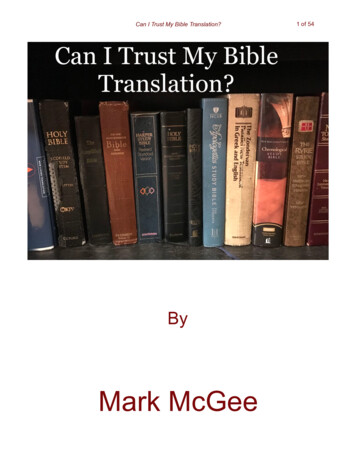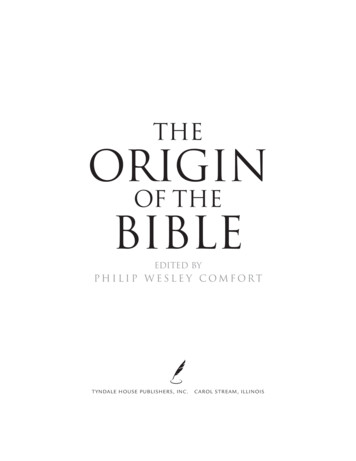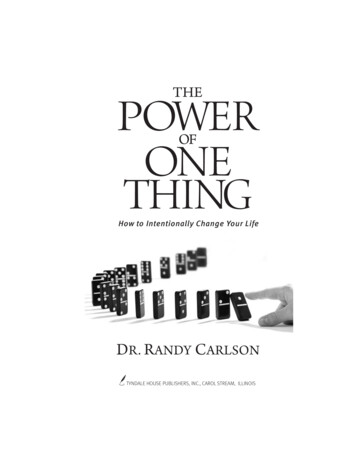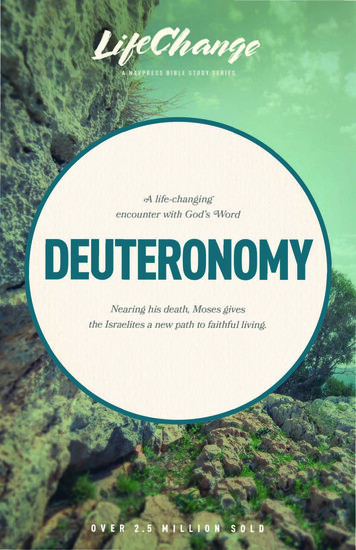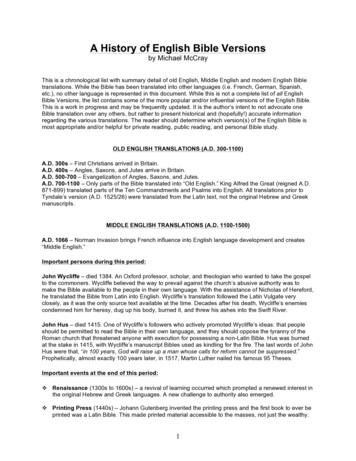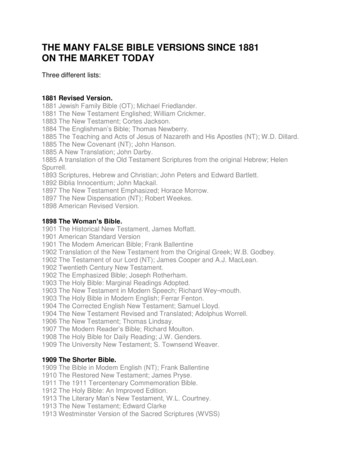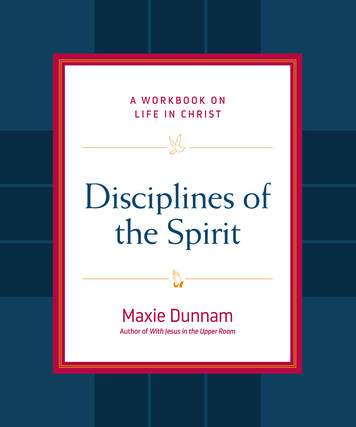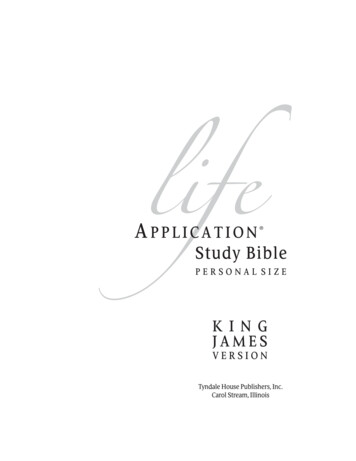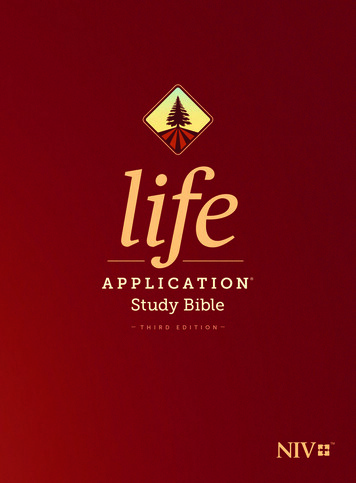
Transcription
LIFEAPPLICATIONSTUDYBIBLE
LIFE APPLICATIONSTUDY BIBLET H I R DE D I T I O NZondervanGrand Rapids, MichiganandTyndale House Publishers, Inc.Carol Stream, Illinois
The Life Application Study Bible, Third Edition, New International Version, is published jointly by Tyndale HousePublishers, Inc., and Zondervan. Hardcover and LeatherLike editions are published by Tyndale House, and leathersoft,bonded leather and genuine leather editions are published by Zondervan.Tyndale House Publishers gratefully acknowledges the role of Youth for Christ/USA in preparing the Life Applicationnotes and Bible helps.NIV Life Application Study Bible, Third Edition copyright 2019 by Tyndale House Publishers, Inc. All rights reserved.Previous editions copyright 1988, 1989, 1990, 1991, 1993, 1996, 2004, 2007, 2013 by Tyndale House Publishers, Inc.All rights reserved.Notes and Bible helps copyright 1988, 1989, 1990, 1991, 1993, 1996, 2004, 2005, 2013, 2019 by Tyndale HousePublishers, Inc. New Testament notes and Bible helps copyright 1986, 2019 owned by assignment by TyndaleHouse Publishers, Inc. Harmony of the Gospels copyright 1986 by James C. Galvin. Maps in text copyright 1986,1988, 2005, 2013, 2019 by Tyndale House Publishers, Inc. All rights reserved. Used by permission of Tyndale HousePublishers, Inc.Updates and revisions of all Life Application materials, the article “The Time between the Old & New Testaments,” andthe articles in “A Christian Worker’s Resource” were produced by The Livingstone Corporation.NIV Concordance copyright 1982, 1984, 2011 by Zondervan.NIV Cross-reference system copyright 1991 by Zondervan. All rights reserved. Used by permission of Zondervan.Color maps by International Mapping. Copyright 2009, 2011 by Zondervan. All rights reserved.Illustrations are the property of their respective copyright holders, and all rights are reserved. Pine tree Julia-art/Shutterstock; leaves Lisa Glanz/Design Cuts; petal pattern Curly Pat/Creative Market; head profile aleciccotelli/AdobeStock; compass copyright Kanate/Shutterstock; book opener illustrations 2004 by Tracy Walker.Other interior illustrations copyright 2015 by Tyndale House Publishers, Inc. All rights reserved.The Bible text used in this edition of the Life Application Study Bible is the Holy Bible, New International Version. The Holy Bible, New International Version. Copyright 1973, 1978, 1984, 2011 by Biblica, Inc. The “NIV” and “New International Version” trademarks are registered in the United States Patent and Trademark Officeby Biblica, Inc. Use of either trademark requires the permission of Biblica, Inc. The NIV text may be quoted in any form (written, visual, electronic or audio), up to and inclusive of five hundred (500)verses without the express written permission of the publisher, providing the verses quoted do not amount to a completebook of the Bible nor do the verses quoted account for twenty-five percent (25%) or more of the total text of the work inwhich they are quoted.Notice of copyright must appear on the title or copyright page as follows:Scripture quotations taken from the Holy Bible, New International Version, NIV. Copyright 1973, 1978, 1984,2011 by Biblica, Inc. Used by permission. All rights reserved worldwide.When quotations from the NIV text are used by a local church in nonsalable media such as church bulletins, ordersof service, posters, overhead transparencies, or similar materials, a complete copyright notice is not required, but theinitials NIV must appear at the end of each quotation.Any commentary or other biblical reference work produced for commercial sale that uses the NIV text must obtainwritten permission for use of the NIV text.Permission requests for commercial use within the USA and Canada that exceeds the above guidelines must be directedto, and approved in writing by Zondervan, 3900 Sparks Drive, Grand Rapids, MI 49546, USA. www.Zondervan.comPermission requests for commercial use within the UK, EU and EFTA that exceeds the above guidelines must be directedto, and approved in writing by Hodder & Stoughton Limited, Carmelite House, 50 Victoria Embankment, London EC4Y0DZ, United Kingdom. www.Hodder.co.ukPermission requests for non-commercial use that exceeds the above guidelines must be directed to, and approved inwriting by Biblica US, Inc., 1820 Jet Stream Drive, Colorado Springs, CO 80921, USA. www.Biblica.comAny Internet addresses (websites, blogs, etc.) and telephone numbers printed in this Bible are offered as a resource. Theyare not intended in any way to be or imply an endorsement by Zondervan, nor does Zondervan vouch for the content ofthese sites and numbers for the life of the Bible.Copublished by:Tyndale House Publishers, Inc., Carol Stream, Illinois 60188, USAZondervan, Grand Rapids, Michigan 49546, USATYNDALE, Life Application, Life App, the Life App logo, and LeatherLike are registered trademarks of Tyndale HousePublishers, Inc.For information about special discounts for bulk purchases, please contact Tyndale House Publishers atcsresponse@tyndale.com, or call 1-800-323-9400.Library of Congress Cataloging-in-Publication DataNames: Tyndale House Publishers, publisher.Title: Life application study Bible.Other titles: Bible. English. New International Version. 2019.Description: Third edition. Carol Stream, Illinois : Tyndale House Publishers, Inc., [2019] Includes index.Identifiers: LCCN 2018061452 ISBN 9781496433831 (hc) ISBN 9781496439413 (hc indexed) ISBN 9781496439420 (leatherlike) ISBN 9781496439451 (leatherlike indexed)Classification: LCC BS195 .N37 2019 DDC 220.5/20814—dc23 LC record available at https://lccn.loc.gov/2018061452ISBN 978-1-4964-3383-1 HardcoverISBN 978-1-4964-3941-3 Hardcover IndexedISBN 978-1-4964-3946-8 Hardcover Red LetterISBN 978-1-4964-4204-8 Hardcover Red Letter IndexedISBN 978-1-4964-3942-0 LeatherLike Brown/TanISBN 978-1-4964-3943-7 LeatherLike Brown/Tan IndexedISBN 978-1-4964-3944-4 LeatherLike BerryISBN 978-1-4964-3945-1 LeatherLike Berry IndexedNIV Life Application Study Bible, Third Edition will also be available in large print and personal size editions in spring 2020.Printed in South Korea25 24 23 22 21 20 197 6 5 4 3 2 1
ContentsA7List of the Books of the BibleA9Alphabetical List of the Books of the BibleA11The NIV Cross-Reference System and AbbreviationsA13PrefaceA17ContributorsA18Why the Life Application Study Bible Is UniqueA18A Chronology of Bible Events and World EventsA20What Is Application?A22Features of the Life Application Study Bible1THE OLD TESTAMENT556A Harmony of the Books of Kings & Chronicles1571The Time between the Old & New Testaments1575THE NEW TESTAMENT1853250 Events in the Life of Christ: A Harmony of the Gospels1857Comparison of the Four Gospels1858The Parables of Jesus1859Jesus’ Miracles1860Messianic Prophecies and Fulfillments1906Maps of Paul’s Journeys2249Table of Weights & Measures2251A Christian Worker’s Resource2267365-Day Reading Plan2271Abbreviations in the Master Index2273Master Index2377Index to Charts2381Index to Maps2383Index to Personality Profiles2385NIV Dictionary/Concordancepage A5
Welcome to the Life ApplicationStudy Bible, Third Edition!Since it was first published in 1988, the Life Application Study Biblehas undergone several significant updates. This new, third editionincludes a thorough update of the historic features, along with newand expanded content, to make the LASB even more relevant foryour daily life. With a fresh, two-color design throughout and an improved layout to support the content enhancements, this Biblewill not only help you to understand God’s Word—it will alsogive you everything you need to apply it to your life and begin to experience the life transformation that God wants for us all.
List of the Books of the BibleTHE OLD h1 Samuel2 Samuel1 Kings2 Kings1 2113352 siastesSong of ggaiZechariahMalachiTHE NEW ewMarkLukeJohnActsRomans1 Corinthians2 212128EphesiansPhilippiansColossians1 Thessalonians2 Thessalonians1 Timothy2 052209HebrewsJames1 Peter2 Peter1 John2 John3 JohnJudeRevelationpage A7
Alphabetical Listof the Books of the 9221882199220214943032205ActsAmos1 Chronicles2 ChroniclesColossians1 Corinthians2 aiHebrewsHoseaIsaiahJamesJeremiahJobJoelJohn1 John2 John3 38839745310892085209421002112212115451530Judges1 Kings2 cahNahumNehemiahNumbersObadiah1 Peter2 mansRuth1 Samuel2 SamuelSong of Songs1 Thessalonians2 Thessalonians1 Timothy2 TimothyTitusZechariahZephaniahpage A9
The NIV Cross-Reference SystemThe New International Version has one of the most accurate and best-organized crossreference systems available. The system used in this Bible contains more than 23,500references.The cross-references link words or phrases in the NIV text with counterpart biblicalreferences listed in a side column on every page. The raised letters containing thesecross-references are set in a light italic typeface to distinguish them from the NIV textnote letters, which use a bold typeface.The lists of references are in biblical order with one exception: If reference is made toa verse within the same chapter, that verse (indicated by “ver”) is listed first.In the Old Testament, some references are marked with an asterisk (*), whichmeans that the Old Testament verse or phrase is quoted in the New Testament (see,for example, Genesis 1:3). The corresponding information is provided in the New Testament by the NIV text note (see 2 Corinthians 4:6).Following is a list of abbreviations used in the cross-references:ABBREVIATIONS FOR THE BOOKS OF THE BIBLEGenesis. . . . . . . . . . . . . . . . . GeExodus. . . . . . . . . . . . . . . . . ExLeviticus . . . . . . . . . . . . . . LevNumbers . . . . . . . . . . . . . . NuDeuteronomy. . . . . . . . . . DtJoshua . . . . . . . . . . . . . . . . . JosJudges . . . . . . . . . . . . . . . . . JdgRuth. . . . . . . . . . . . . . . . . . . . . Ru1 Samuel. . . . . . . . . . . . . . 1Sa2 Samuel . . . . . . . . . . . . . . 2Sa1 Kings. . . . . . . . . . . . . . . . . 1Ki2 Kings. . . . . . . . . . . . . . . . . 2Ki1 Chronicles. . . . . . . . . . 1Ch2 Chronicles. . . . . . . . . . 2ChEzra . . . . . . . . . . . . . . . . . . . . EzrNehemiah. . . . . . . . . . . . . . NeEsther. . . . . . . . . . . . . . . . . . EstJob. . . . . . . . . . . . . . . . . . . . . . JobPsalms. . . . . . . . . . . . . . . . . . PsProverbs. . . . . . . . . . . . . . . . PrEcclesiastes. . . . . . . . . . . EccSong of Songs . . . . . . . . . SSIsaiah. . . . . . . . . . . . . . . . . . IsaJeremiah. . . . . . . . . . . . . . . . JerLamentations. . . . . . . . . . LaEzekiel. . . . . . . . . . . . . . . . . EzeDaniel . . . . . . . . . . . . . . . . . . DaHosea. . . . . . . . . . . . . . . . . HosJoel. . . . . . . . . . . . . . . . . . . . JoelAmos. . . . . . . . . . . . . . . . . . . AmObadiah. . . . . . . . . . . . . . . ObJonah . . . . . . . . . . . . . . . . . . JnhMicah. . . . . . . . . . . . . . . . . MicNahum . . . . . . . . . . . . . . . . . NaHabakkuk. . . . . . . . . . . . HabZephaniah . . . . . . . . . . . ZepHaggai. . . . . . . . . . . . . . . . HagZechariah . . . . . . . . . . . . . ZecMalachi. . . . . . . . . . . . . . . MalMatthew. . . . . . . . . . . . . . . . MtMark . . . . . . . . . . . . . . . . . . . MkLuke. . . . . . . . . . . . . . . . . . . . . LkJohn. . . . . . . . . . . . . . . . . . . . . JnActs . . . . . . . . . . . . . . . . . . . . . AcRomans. . . . . . . . . . . . . . . . . Ro1 Corinthians . . . . . . . . . 1Co2 Corinthians . . . . . . . . 2CoGalatians. . . . . . . . . . . . . . GalEphesians. . . . . . . . . . . . EphPhilippians . . . . . . . . . . PhpColossians . . . . . . . . . . . . Col1 Thessalonians. . . . . . 1Th2 Thessalonians. . . . . 2Th1 Timothy. . . . . . . . . . . . . . 1Ti2 Timothy . . . . . . . . . . . . . 2TiTitus . . . . . . . . . . . . . . . . . TitusPhilemon. . . . . . . . . . . . PhmHebrews. . . . . . . . . . . . . . HebJames . . . . . . . . . . . . . . . . . . Jas1 Peter . . . . . . . . . . . . . . . . . 1Pe2 Peter . . . . . . . . . . . . . . . . . 2Pe1 John. . . . . . . . . . . . . . . . . . 1Jn2 John. . . . . . . . . . . . . . . . . . 2Jn3 John. . . . . . . . . . . . . . . . . . 3JnJude. . . . . . . . . . . . . . . . . . JudeRevelation. . . . . . . . . . . . Revpage A11
PrefaceThe goal of the New International Version (NIV) is to enable English-speaking people from aroundthe world to read and hear God’s eternal Word in their own language. Our work as translators is motivated by our conviction that the Bible is God’s Word in written form. We believe that the Bible containsthe divine answer to the deepest needs of humanity, sheds unique light on our path in a dark world andsets forth the way to our eternal well-being. Out of these deep convictions, we have sought to recreateas far as possible the experience of the original audience—blending transparency to the original textwith accessibility for the millions of English speakers around the world. We have prioritized accuracy,clarity and literary quality with the goal of creating a translation suitable for public and private reading, evangelism, teaching, preaching, memorizing and liturgical use. We have also sought to preserve ameasure of continuity with the long tradition of translating the Scriptures into English.The complete NIV Bible was first published in 1978. It was a completely new translation made byover a hundred scholars working directly from the best available Hebrew, Aramaic and Greek texts.The translators came from the United States, Great Britain, Canada, Australia and New Zealand, givingthe translation an international scope. They were from many denominations and churches— including Anglican, Assemblies of God, Baptist, Brethren, Christian Reformed, Church of Christ, EvangelicalCovenant, Evangelical Free, Lutheran, Mennonite, Methodist, Nazarene, Presbyterian, Wesleyan andothers. This breadth of denominational and theological perspective helped to safeguard the translationfrom sectarian bias. For these reasons, and by the grace of God, the NIV has gained a wide readershipin all parts of the English-speaking world.The work of translating the Bible is never finished. As good as they are, English translations must beregularly updated so that they will continue to communicate accurately the meaning of God’s Word.Updates are needed in order to reflect the latest developments in our understanding of the biblicalworld and its languages and to keep pace with changes in English usage. Recognizing, then, that theNIV would retain its ability to communicate God’s Word accurately only if it were regularly updated,the original translators established the Committee on Bible Translation (CBT). The Committee is a selfperpetuating group of biblical scholars charged with keeping abreast of advances in biblical scholarship and changes in English and issuing periodic updates to the NIV. The CBT is an independent,self-governing body and has sole responsibility for the NIV text. The Committee mirrors the originalgroup of translators in its diverse international and denominational makeup and in its unifying commitment to the Bible as God’s inspired Word.In obedience to its mandate, the Committee has issued periodic updates to the NIV. An initial revision was released in 1984. A more thorough revision process was completed in 2005, resulting in theseparately published TNIV. The updated NIV you now have in your hands builds on both the originalNIV and the TNIV and represents the latest effort of the Committee to articulate God’s unchangingWord in the way the original authors might have said it had they been speaking in English to the globalEnglish-speaking audience today.TRANSLATION PHILOSOPHYThe Committee’s translating work has been governed by three widely accepted principles about the waypeople use words and about the way we understand them.First, the meaning of words is determined by the way that users of the language actually use them atany given time. For the biblical languages, therefore, the Committee utilizes the best and most recentscholarship on the way Hebrew, Aramaic and Greek words were being used in biblical times. At thesame time, the Committee carefully studies the state of modern English. Good translation is like goodcommunication: one must know the target audience so that the appropriate choices can be made aboutwhich English words to use to represent the original words of Scripture. From its inception, the NIV hashad as its target the general English-speaking population all over the world, the “International” in itstitle reflecting this concern. The aim of the Committee is to put the Scriptures into natural English thatwill communicate effectively with the broadest possible audience of English speakers.Modern technology has enhanced the Committee’s ability to choose the right English words to conveythe meaning of the original text. The field of computational linguistics harnesses the power of computers to provide broadly applicable and current data about the state of the language. Translators cannow access huge databases of modern English to better understand the current meaning and usageof key words. The Committee utilized this resource in preparing the 2011 edition of the NIV. An areaof especially rapid and significant change in English is the way certain nouns and pronouns are usedpage A13
P refa c e page A14to refer to human beings. The Committee therefore requested experts in computational linguistics atCollins Dictionaries to pose some key questions about this usage to its database of English—the largestin the world, with over 4.4 billion words, gathered from several English-speaking countries and including both spoken and written English. (The Collins Study, called “The Development and Use of GenderLanguage in Contemporary English,” can be accessed at http://www.thenivbible.com/about-the -niv /about-the-2011-edition/.) The study revealed that the most popular words to describe the human racein modern U.S. English were “humanity,” “man” and “mankind.” The Committee then used this datain the updated NIV, choosing from among these three words (and occasionally others also) d ependingon the context.A related issue creates a larger problem for modern translations: the move away from using the thirdperson masculine singular pronouns—“he/him/his”—to refer to men and women equally. This usagedoes persist in some forms of English, and this revision therefore occasionally uses these pronouns ina generic sense. But the tendency, recognized in day-to-day usage and confirmed by the Collins study,is away from the generic use of “he,” “him” and “his.” In recognition of this shift in language and in aneffort to translate into the natural English that people are actually using, this revision of the NIV generally uses other constructions when the biblical text is plainly addressed to men and women equally.The reader will encounter especially frequently a “they,” “their” or “them” to express a generic singularidea. Thus, for instance, Mark 8:36 reads: “What good is it for someone to gain the whole world, yet forfeit their soul?” This generic use of the “distributive” or “singular” “they/them/their” has been used formany centuries by respected writers of English and has now become established as standard English,spoken and written, all over the world.A second linguistic principle that feeds into the Committee’s translation work is that meaning isfound not in individual words, as vital as they are, but in larger clusters: phrases, clauses, sentences,discourses. Translation is not, as many people think, a matter of word substitution: English word xin place of Hebrew word y. Translators must first determine the meaning of the words of the biblicallanguages in the context of the passage and then select English words that accurately communicatethat meaning to modern listeners and readers. This means that accurate translation will not alwaysreflect the exact structure of the original language. To be sure, there is debate over the degree to whichtranslators should try to preserve the “form” of the original text in English. From the beginning, theNIV has taken a mediating position on this issue. The manual produced when the translation thatbecame the NIV was first being planned states: “If the Greek or Hebrew syntax has a good parallelin modern English, it should be used. But if there is no good parallel, the English syntax appropriateto the meaning of the original is to be chosen.” It is fine, in other words, to carry over the form of the biblical languages into English—but not at the expense of natural expression. The principle that meaning resides in larger clusters of words means that the Committee has not insisted on a “word-for-word”approach to translation. We certainly believe that every word of Scripture is inspired by God and therefore to be carefully studied to determine what God is saying to us. It is for this reason that the Committeelabors over every single word of the original texts, working hard to determine how each of those wordscontributes to what the text is saying. Ultimately, however, it is how these individual words function incombination with other words that determines meaning.A third linguistic principle guiding the Committee in its translation work is the recognition that wordshave a spectrum of meaning. It is popular to define a word by using another word, or “gloss,” to substitute for it. This substitute word is then sometimes called the “literal” meaning of a word. In fact,however, words have a range of possible meanings. Those meanings will vary depending on the context, and words in one language will usually not occupy the same semantic range as words in anotherlanguage. The Committee therefore studies each original word of Scripture in its context to identify itsmeaning in a particular verse and then chooses an appropriate English word (or phrase) to representit. It is impossible, then, to translate any given Hebrew, Aramaic or Greek word with the same Englishword all the time. The Committee does try to translate related occurrences of a word in the originallanguages with the same English word in order to preserve the connection for the English reader. Butthe Committee generally privileges clear natural meaning over a concern with consistency in renderingparticular words.TEXTUAL BASISFor the Old Testament the standard Hebrew text, the Masoretic Text as published in the latest edition ofBiblia Hebraica, has been used throughout. The Masoretic Text tradition contains marginal notationsthat offer variant readings. These have sometimes been followed instead of the text itself. Becausesuch instances involve variants within the Masoretic tradition, they have not been indicated in thetextual notes. In a few cases, words in the basic consonantal text have been divided differently than
page A15 P refa c ein the Masoretic Text. Such cases are usually indicated in the textual footnotes. The Dead Sea Scrollscontain biblical texts that represent an earlier stage of the transmission of the Hebrew text. They havebeen consulted, as have been the Samaritan Pentateuch and the ancient scribal traditions concerningdeliberate textual changes. The translators also consulted the more important early versions. Readingsfrom these versions, the Dead Sea Scrolls and the scribal traditions were occasionally followed wherethe Masoretic Text seemed doubtful and where accepted principles of textual criticism showed that oneor more of these textual witnesses appeared to provide the correct reading. In rare cases, the translatorshave emended the Hebrew text where it appears to have become corrupted at an even earlier stage ofits transmission. These departures from the Masoretic Text are also indicated in the textual footnotes.Sometimes the vowel indicators (which are later additions to the basic consonantal text) found in theMasoretic Text did not, in the judgment of the translators, represent the correct vowels for the originaltext. Accordingly, some words have been read with a different set of vowels. These instances are usuallynot indicated in the footnotes.The Greek text used in translating the New Testament has been an eclectic one, based on the latesteditions of the Nestle-Aland/United Bible Societies’ Greek New Testament. The translators have madetheir choices among the variant readings in accordance with widely accepted principles of New Testament textual criticism. Footnotes call attention to places where uncertainty remains.The New Testament authors, writing in Greek, often quote the Old Testament from its ancient Greekversion, the Septuagint. This is one reason why some of the Old Testament quotations in the NIV NewTestament are not identical to the corresponding passages in the NIV Old Testament. Such quotationsin the New Testament are indicated with the footnote “(see Septuagint).”FOOTNOTES AND FORMATTINGFootnotes in this version are of several kinds, most of which need no explanation. Those giving alternative translations begin with “Or” and generally introduce the alternative with the last word precedingit in the text, except when it is a single-word alternative. When poetry is quoted in a footnote a slashmark indicates a line division.It should be noted that references to diseases, minerals, flora and fauna, architectural details, clothing, jewelry, musical instruments and other articles cannot always be identified with precision. Also,linear measurements and measures of capacity can only be approximated (see the Table of Weightsand Measures). Although Selah, used mainly in the Psalms, is probably a musical term, its meaningis uncertain. Since it may interrupt reading and distract the reader, this word has not been kept in theEnglish text, but every occurrence has been signaled by a footnote.As an aid to the reader, sectional headings have been inserted. They are not to be regarded as part ofthe biblical text and are not intended for oral reading. It is the Committee’s hope that these headingsmay prove more helpful to the reader than the traditional chapter divisions, which were introducedlong after the Bible was written.Sometimes the chapter and/or verse numbering in English translations of the Old Testament differs from that found in published Hebrew texts. This is particularly the case in the Psalms, where thetraditional titles are included in the Hebrew verse numbering. Such differences are indicated in thefootnotes at the bottom of the page. In the New Testament, verse numbers that marked off portions ofthe traditional English text not supported by the best Greek manuscripts now appear in brackets, witha footnote indicating the text that has been omitted (see, for example, Matthew 17:[21]).Mark 16:9–20 and John 7:53—8:11, although long accorded virtually equal status with the rest of theGospels in which they stand, have a questionable standing in the textual history of the New Testament,as noted in the bracketed annotations with which they are set off. A different typeface has been chosenfor these passages to indicate their uncertain status.Basic formatting of the text, such as lining the poetry, paragraphing (both prose and poetry), settingup of (administrative-like) lists, indenting letters and lengthy prayers within narratives and the insertion of sectional headings, has been the work of the Committee. However, the choice between singlecolumn and double-column formats has been left to the publishers. Also the issuing of “red-letter”editions is a publisher’s choice—one that the Committee does not endorse.The Committee has again been reminded that every human effort is flawed—including this revisionof the NIV. We trust, however, that many will find in it an improved representation of the Word of God,through which they hear his call to faith in our Lord Jesus Christ and to service in his kingdom. We offerthis version of the Bible to him in whose name and for whose glory it has been made.The Committee on Bible Translation
ContributorsSENIOR EDITORIAL TEAMZONDERVAN DEVELOPMENT TEAMDr. Bruce B. BartonRonald A. BeersDr. James C. GalvinLaVonne NeffLinda Chaffee TaylorDavid R. VeermanPhil HerichMichael A. Vander KlippGENERAL EDITORTYNDALE HOUSE TYPESETTINGRonald A. BeersTYNDALE HOUSE BIBLE EDITORSDr. Philip W. ComfortMark R. NortonRobert K. BrownVirginia MuirDel LankfordLeanne RollandEllen R. VosburgJonathan BryantTYNDALE HOUSEPROOFREADING COORDINATORDeb LewTYNDALE HOUSE COPYEDITINGCOORDINATORSarah K. JohnsonPROOFREADINGPeachtree Editorial ServicesBOOK INTRODUCTIONSDavid R. VeermanBOOK OUTLINES,BLUEPRINTS, HARMONYDr. James C. GalvinMEGATHEMESDr. Bruce B. BartonMAP DEVELOPMENT &COMPUTER OPERATIONLinda Chaffee TaylorCOLOR MAP CONSULTANTDr. Barry BeitzelCHARTS & DIAGRAMSNeil S. WilsonRonald A. BeersDavid R. VeermanPamela YorkPERSONALITY PROFILESNeil S. WilsonDESIGN & DEVELOPMENT TEAMDr. Bruce B. BartonRonald A. BeersDr. James C. GalvinDavid R. VeermanTYNDALE HOUSE DESIGNDan FarrellJennifer GhionzoliRuth PizziKimberly D. HutsonA CHRONOLOGY O
The Life Application Study Bible, Third Edition, New International Version, is published jointly by Tyndale House Publishers, Inc., and Zondervan. Hardcover and LeatherLike editions are published by Tyndale House, and leathersoft, bonded leather
